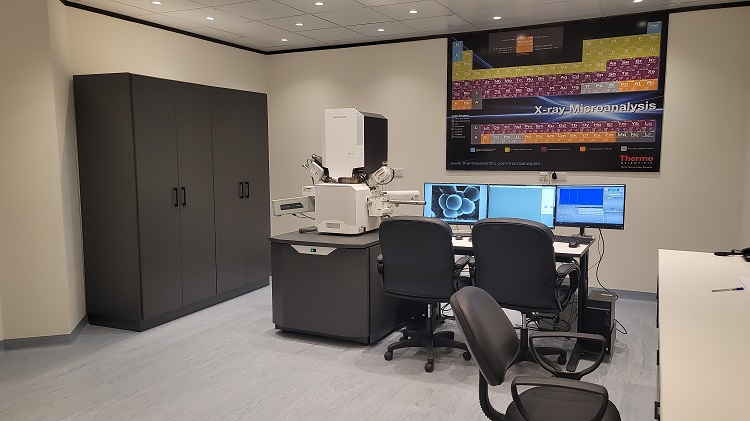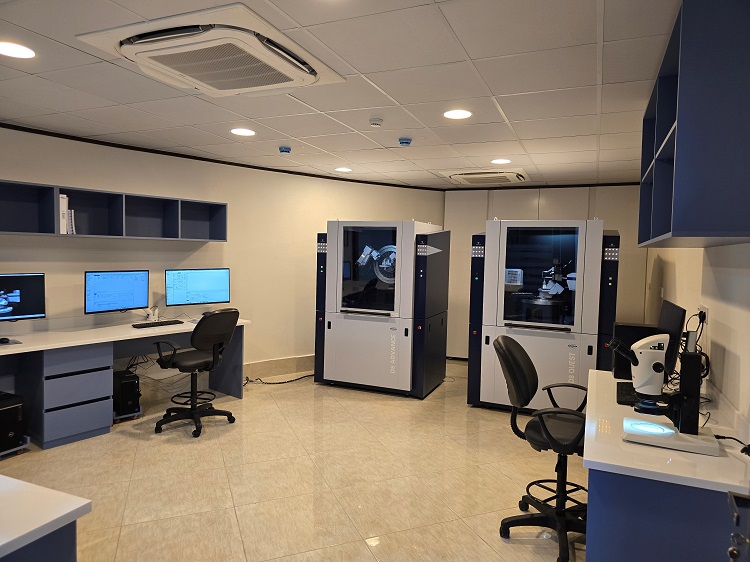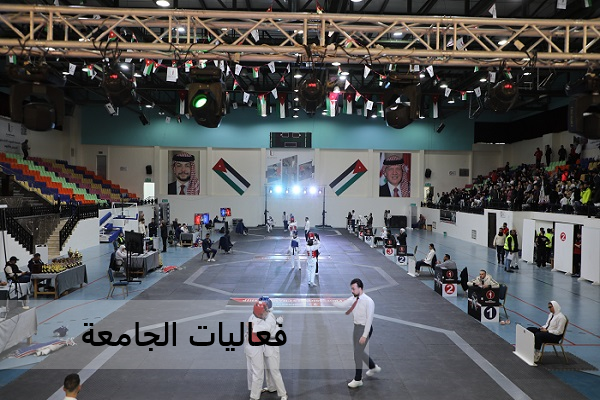مكتب ضمان الجودة
Quality Assurance Office
At IUIC, scientific curiosity meets cutting-edge technology to push the boundaries of knowledge and create solutions for the challenges of tomorrow. The areas IUIC research highlighted the most, were:
- Pharmacy/Life-science.
- Material science/Engineering.
- Physics.
- Chemistry.
- Nano-technology.
في مركز الريادة والإبداع، يلتقي الفضول العلمي مع التكنولوجيا المتقدمة لتوسيع آفاق المعرفة. تشمل مجالات البحث الأساسية ما يلي:
- الصيدلة والعلوم الحياتية
- علم المواد والهندسة
- الفيزياء
- الكيمياء
- تكنولوجيا النانو
مختبر علم المعادن في مركز الريادة والابداع مجهز لتحضير العينات غير البيولوجية بدقة عالية ولفخصها وتحليلها في اجهزة المركز. يضم المختبر مجموعة من الأدوات المتطورة لدعم الأبحاث في مجالات عديدة كعلم المعادن وعلوم المواد والهندسة.
الأجهزة الرئيسية:
- آلة الطحن والتلميع Mopao-3S
جهاز مزود بقرص مزدوج ومخصص لعمليات الطحن والتلميع الآلية بدقة عالية. يتميز بنظام تحكم دقيق يتيح تعديل السرعة بشكل سلس، ويتيح تحضير عينات متعددة في وقت واحد، مما يوفر الوقت والجهد أثناء التشغيل. - منشار قطع العينات المعدنية
آلة قطع متعددة الاستخدامات، مصممة لقطع العينات المعدنية بأنواعها المختلفة. مزودة بنظام تبريد قوي لمنع ارتفاع درجة الحرارة أثناء القطع وحماية العينة من التلف، مع آلية تثبيت سريعة. - جهاز Sputter Coater - Q150T ES Plus
جهاز Q150T ES Plus هو جهاز طلاء للعينات غير المواصلة للكهرباء يسمح بإنتاج صور عالية الدقة بعد عملية الطلاء بمادة موصلة مثل الكربون او الكروم. يتيح رش المعادن المؤكسدة وغير المؤكسدة، مما يجعل العينات جاهزة للتصوير المجهري بتفاصيل دقيقة، خاصةً عند التعامل مع مواد حساسة أو غير موصلة.
يدعم المختبر مختلف مشاريع البحث من خلال توفير عمليات إعداد العينات الأساسية مثل القطع، التلميع، والطحن، ما يساعد في التحليل المجهري باستخدام أجهزة أخرى في مركز الريادة والإبداع مثل XRD و SEM و BET.
The Metallography Lab at IUIC is designed for the high-precision preparation and analysis of metallic materials. This cutting-edge facility is equipped with advanced tools for sample preparation, supporting research and innovation across various fields such as metallurgy, materials science, and engineering.
Key Equipment:
- Mopao-3S Grinding and Polishing Machine
A double-disc desktop machine designed for high-precision automation in grinding and polishing. It features an advanced microprocessor control system for stepless speed adjustments, intuitive sample preparation, and multi-sample testing, ensuring low noise and stability during operation. The Mopao-3S accommodates both sandpaper and fabric for grinding and polishing, providing flexibility in sample preparation. - Large-Capacity Metallographic Cutting Machine
A multifunctional machine designed for cutting various metal specimens, including cylindrical and irregular shapes. It features a double hood for safety, a powerful cooling system to prevent overheating, and a quick clamping mechanism. This ensures precise cuts without damaging the specimen, improving overall efficiency. - Q150T ES Plus Sputter Coater
A turbomolecular pumped sputter coater and carbon evaporation system, capable of sputtering both oxidizing and non-oxidizing metals such as Chromium and Platinum. It provides high-resolution imaging with its small grain size and features a touch screen interface, USB port, and multi-user profiles.
The Metallography Lab supports an array of research projects by providing essential preparation processes such as cutting, mounting, grinding, and sputter coating, which are crucial for microstructural analysis using other instruments available at IUIC like XRD, SEM, and BET.

المجهر الإلكتروني الماسح Apreo 2S من Thermo Fisher في مركز الريادة والإبداع هو جهاز متطور يوفر صورًا عالية الجودة والدقة لمجموعة متنوعة من العينات، سواء كانت عازلة للكهرباء، موادًا الحساسة للأشعة، أو المواد المغناطيسية. يتم ذلك بفضل تقنياته المتطورة في التحكم بحزمة الالكترونات وأنظمة تلقي الإشارة, مما يجعله مثاليا للباحثين الذين يتطلعون الى نتائج موثوقة وعالية الجودة
يحقق المجهر دقة تصل إلى 0.5 نانومتر في تصوير المواد مثل جسيمات النانو، المساحيق، المحفزات، والأجهزة النانوية، وحتى العينات المغناطيسية الضخمة. في حالة العينات غير الموصلة، يمكن الحصول على صور عالية الدقة باستخدام عملية Sputter coating أو من خلال Low-Vacuum mode الموجود في الجهاز.
يتميز الجهاز بجودة صورة ممتازة وتباين قوي حتى مع العينات الصعبة. كما يدعم رسم الخرائط الكيميائية لتحليل العناصر بشكل فوري والتحليل الكيميائي الملون. بفضل نظام الكشف Trinity™، يوفر الجهاز معلومات شاملة عن العينات.
يتضمن المجهر كاشف STEM 3+ القابل للسحب، والذي يحتوي على 11 مقطعًا يمكن التحكم بها، مما يوفر دقة أعلى من المجاهر التقليدية ويسمح بتصوير يشبه TEM للجسيمات الصغيرة دون الحاجة إلى دقة ذرية.
يشمل المجهر أوضاع تصوير (SE) و (BSE)، و كاميرا (EBSD) وتحليل طيف العناصر (EDS)، بالإضافة إلى 13 كاشف متخصص لأنواع الإشارات المتعددة. هذه الميزات تجعل المجهر مثاليًا لفحص المواد، تصوير العينات البيولوجية، ودعم أبحاث النانو.

The Thermo Fisher Apreo 2 SEM at IUIC is a state-of-the-art instrument delivering high-quality, high-resolution imaging for various sample types. Insulators, beam-sensitive materials, and magnetic samples are easily imaged, thanks to its advanced optics, detection, and beam control features. This allows for exceptional imaging performance, even for challenging samples, making it ideal for researchers and professionals seeking reliable and high-quality SEM analysis.
The Apreo 2S achieves 0.5 nanometer resolution on materials like nanoparticles, powders, catalysts, and bulk magnetic samples. Non-conductive samples can also be imaged at high resolution using either the sputter coating process at IUIC or the SEM’s low-vacuum mode.
The system offers exceptional image quality across diverse materials, with high contrast even for difficult samples. It supports live elemental mapping for real-time analysis and elemental color SEM. With the Trinity™ Detection System, providing maximum information from each sample.
Another key feature is the STEM 3+ detector, a retractable system with 11 individually addressable segments that offers better resolution than traditional SEM. It allows for TEM-like imaging without the need for atomic-level resolution, making it ideal for analyzing nanoparticles and other small structures.
IUIC’s Apreo 2 SEM also includes secondary and backscattered electron imaging, EDS analysis, EBSD camera and specialized detectors for low-vacuum imaging. The combination of 13 powerful detectors and versatile imaging modes makes this SEM perfect for a range of applications, from material characterization and biological imaging to nanotechnology research.
جهاز تحليل (TGA) هو أداة تُستخدم على نطاق واسع في علم المواد والأبحاث. يعمل عن طريق قياس تغير الوزن للعينة أثناء تعرضها لتغيرات درجة حرارة محكومة في بيئة غازية. ومع ارتفاع درجة الحرارة، يكشف جهاز TGA فقدان أو كسب الوزن للعينة، مما يوفر معلومات هامة حول الخصائص الحرارية للمواد وثباتها الحراري وتركيبها وفهم سلوك المواد تحت ظروف مختلفة. يُعَدُّ جهاز TGA أساسيًا في فحص مجموعة واسعة من المواد. التطبيقات تشمل:
- فحص البوليمرات (صناعة البلاستيك).
- صناعة الأدوية (اختبار الاستقرار).
- تقييم الدهانات ومقاومتها للحرارة.
- تحليل مواد العزل الحراري.
- فحص المواد المستخدمة في تصنيع البطاريات والخلايا الشمسية.
- دراسة تأثير درجة الحرارة على المواد المستخدمة في إنتاج المحفزات. (catalysts)
- اختبار الأفلام الرقيقة والمواد الصلبة المستخدمة في صناعة السيراميك ومواد البناء.
جهاز(BET) هو أداة قوية تُستخدم لقياس المساحة السطحية النوعية للمواد الصلبة. يعمل الجهاز على مبدأ امتزاز الغاز على سطح المادة، مما يسمح بتحديد المساحة السطحية وتوزيع حجم المسام. يُستخدم الجهاز على نطاق واسع في الصناعات والشركات التي تركز على تطوير وتصنيع المواد التي تتطلب مساحة سطحية كبيرة وفعالة:
- صناعة المحفزات: في صناعات مثل البترول، والكيماويات، والسيارات.
- صناعة الأغذية والمشروبات: لقياس المساحة السطحية للمضافات الغذائية لتحسين خصائصها وتعزيز النكهة.
- شركات الأدوية: لقياس المساحة السطحية للمواد لتحسين فعالية الأدوية وامتصاصها.
- صناعة البطاريات وتخزين الطاقة: لدراسة المواد المستخدمة في البطاريات وتخزين الطاقة.
- الإلكترونيات وتقنية النانو: لدراسة خصائص المواد والأفلام الرقيقة المستخدمة في الإلكترونيات وتقنية النانو.
- اختبار الجودة والكفاءة لمواد البناء والعزل.
Thermogravimetric Analysis (TGA) is a powerful tool widely used in materials science and research. It works by measuring the weight change of a sample as it is subjected to controlled temperature variations in a gaseous environment. As the temperature increases, the TGA detects the weight loss or gain of the sample, providing valuable information about its thermal stability, decomposition behavior, and composition. TGA is essential for characterizing a wide range of materials, including polymers, minerals, pharmaceuticals, and catalysts. Its precise and sensitive measurements make it an indispensable tool in studying thermal properties and understanding material behavior under various conditions.
Applications:
- Examination of polymers (plastic industry).
- Pharmaceutical industry (stability).
- Evaluation of paints and their heat resistance.
- Analysis of thermal insulation materials
- Examination of materials used in battery and solar cell manufacturing.
- Study of the temperature effect on materials used in catalyst production.
- Testing of thin films and solid materials used in ceramic and construction material manufacturing
Brunauer-Emmett-Teller (BET) Analyzer is a powerful tool used to measure the specific surface area of solid materials. It operates on the principle of gas adsorption onto the material's surface, allowing for the determination of surface area and pore size distribution.
The device is widely used in industries and companies that focus on the development and manufacturing of materials requiring a large and effective surface area:
- Catalysts Industry: In industries such as petroleum, chemicals, and automotive.
- Food and Beverage Industry: Measuring the surface area of additives in food to improve their properties and enhance flavor.
- Pharmaceutical Companies: Measuring the surface area of materials to improve drug efficacy and absorption.
- Battery and Energy Storage Industry: Studying the materials used in batteries and energy storage.
- Electronics and Nanotechnology: Studying the properties of materials and thin films used in electronics and nanotechnology.
- Quality and Efficiency Testing of Building Materials and Insulation.

جهاز D8 ADVANCE XRD من Bruker هو نظام متقدم لتحليل حيود الأشعة السينية، يمكن استخدامه لتنفيذ مجموعة واسعة من تحاليل المواد. يتميز هذا الجهاز بمكشاف عالي الدقة هو الأعلى بين جميع أجهزة حيود الأشعة السينية الأخرى، ويمكنه تحليل جميع أنواع العينات بما في ذلك السوائل، المساحيق غير المضغوطة، الأغشية الرقيقة، والكتل الصلبة. تشمل التطبيقات الرئيسية لهذا الجهاز:
- حيود الأشعة السينية التقليدي للمساحيق (XRD) لتحديد البنية البلورية.
- تحليل توزيع الأزواج (PDF) الذي يتيح فهم توزيع الذرات على المستوى المحلي.
- تشتت الأشعة السينية بزوايا صغيرة وكبيرة (SAXS, WAXS) لدراسة الهياكل على نطاق النانو.
- حيود المساحيق لتحليل المواد غير العضوية.
- تحليل الأغشية الرقيقة والطلاءات لتحديد سماكتها وتكوينها.
- تحليل القوام لمعرفة اتجاهات البلورات.
- تحليل الإجهاد المتبقي لتقييم مستويات الإجهاد الداخلي في المواد.
جهاز D8 QUEST هو أداة متقدمة مخصصة لتجارب الطول الموجي الأحادي. يُعد الجهاز مثاليًا لتحديد الهيكل الذري ثلاثي الأبعاد للبلورات الأحادية، مما يمكّن من إجراء أبحاث رائدة في مجموعة متنوعة من المجالات العلمية. تشمل المزايا العلمية والتقنية التي يقدمها الجهاز:
- كاشف PHOTON II المعتمد على تقنية CPAD لتوفير دقة عالية في الكشف.
- كاشف PHOTON III لعد الفوتونات بتقنية الوضع المختلط، ما يعزز جودة البيانات في التجارب ذات الحساسية العالية.
- مصادر الأشعة السينية الدقيقة (IµS 3.0) و (IµS DIAMOND II) التي توفر أشعة مركزة، مما يزيد من دقة التحليل.
- جهاز توجيه رباعي المحاور (FIXED-CHI) أو( KAPPA)الذي يدعم التحكم المحوري في إعداد العينات.
- البرامج المتكاملة مثل APEX5 لدراسات البلورات الكيميائية وPROTEUM5 لعلوم الأحياء الهيكلية، حيث تم تصميمها لتسهيل معالجة البيانات الهيكلية المعقدة.





